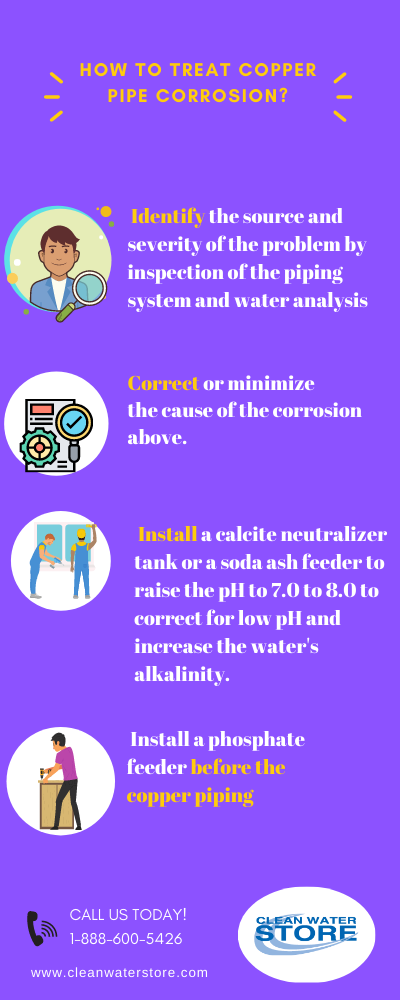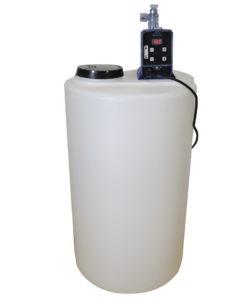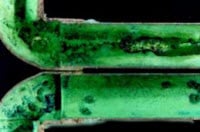 According to some estimates, copper pipe corrosion costs the United States more than $1 billion a year. Copper corrosion in home plumbing systems is a common phenomenon, which can have many causes.
According to some estimates, copper pipe corrosion costs the United States more than $1 billion a year. Copper corrosion in home plumbing systems is a common phenomenon, which can have many causes.
Besides actual piping failure, the telltale blue stains the oxidized copper leaves on sinks, tubs, and fixtures can identify copper corrosion.
Often laundry and even blonde hair can be tinted blue. Copper pipe corrosion may cause toxic levels of copper and lead to contaminate your water. Water containing levels over 1.0 mg/L should not be used for drinking.
If there are iron pipes present, the water can be colored rust or reddish and contain metallic or sulfur odors and sediment. Eventually, corrosion can cause the piping to fail, in some cases in less than 10 years.
What is Corrosion?
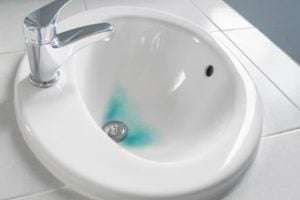
Corrosion is “the deterioration of a substance or its properties due to a reaction with its environment.”
In plain words, the metal from the piping dissolves into the water due to various causes, creating pipe failure and corrosion of water heaters, appliances, and fixtures.
Blue corrosion on copper pipes and plumbing systems is due to physical and chemical reactions between the pipe material and water.
The main causes of pipe corrosion are:
- Low pH (acid water) is typically found on private well water but is also present in some small municipal water systems.
- Other water chemistry causes high levels of dissolved oxygen, high levels of salts dissolved in the water, and/ or corrosion-causing bacteria such as sulfate or iron bacteria.
- Electrochemical causes, such as the improper grounding of electrical appliances to the copper piping.
- The high velocity of water, relative to the size of piping, causing hydraulic wear on the piping, for instance, a recirculating hot water system with a pump driving the water through pipes that are too small in diameter.
- Poor plumbing installation practices, including not cleaning or de-burring the pipe properly and excessive flux in soldering the pipe fittings.
- Sand, sediment, or other grit causing hydraulic wear on the piping.
- Lightning strikes utility poles where the electricity travels to ground wires connecting to piping systems
What can be done? How to Clean Copper Pipe Corrosion
1. Identify the source and severity of the problem by inspection of the piping system and water analysis:
-
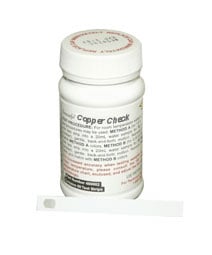
Easy to Use Home Copper Pipe Corrosion Test Kit Check to see if there are unnecessary electrical appliances or wiring connected to the piping.
- Do a first draw copper test. Find out how high the levels of your copper are. To do this wait overnight and draw some water and test for copper (this is called a “first draw test”) using a home copper test kit.
- Check to see if the piping system is properly grounded. Verify that there is electrical continuity throughout the piping system.
- Check for pH, hardness, alkalinity, total dissolved solids and see if the water is corrosive, and perform a Langelier Index.
- You can use our Online Langelier Index Calculator.
2. Correct or minimize the cause of the corrosion above.
3. Install a calcite neutralizer tank or a soda ash feeder to raise the pH to 7.0 to 8.0 to correct for low pH and increase the water's alkalinity.
4. Install a phosphate feeder before the copper piping. Phosphate will coat the piping and reduce or slow down the corrosion effects by coating the piping's interior surfaces with phosphate and causing an insulation surface to be built up.
Calcite Neutralizer Filters
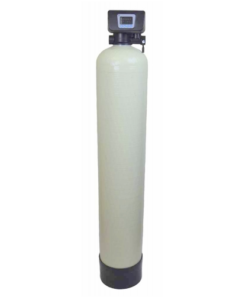 One of the most convenient methods to raise pH and add a little hardness and alkalinity is to use a calcite neutralizer filter. These filters will typically raise the water's pH to 7.0 to 8.0 and add 30 to 100 ppm of hardness depending on the alkalinity and water hardness.
One of the most convenient methods to raise pH and add a little hardness and alkalinity is to use a calcite neutralizer filter. These filters will typically raise the water's pH to 7.0 to 8.0 and add 30 to 100 ppm of hardness depending on the alkalinity and water hardness.
In neutralizer filters, acidic waters slowly dissolve the calcium and magnesium media on contact as the water flows through the filter, raising the water's pH and increasing the alkalinity. This water system eliminates the effects of corrosive water chemistries and is a good solution for preventing copper pipe corrosion and corrosion of fixtures.
The size of the system is directly proportional to the flow rate of the water, in gallons per minute. The higher the flow rate, the larger the system required.
Neutralizer filter tanks are filled with a blend of calcium and magnesium carbonates made from naturally occurring minerals. These minerals dissolve into the water, making it less corrosive. More minerals can quickly and easily be added to the filter tank, typically once per year for most residential applications. No special tools are required.
This type of neutralizer also acts as a filter to remove sediment and small amounts of rust from the water and then backwash it out once every week.
Soda Ash Feeders
A small pump called a metering pump is used to inject a small amount of soda ash (sodium carbonate) into the water, usually combined with a contact tank.
For best results, allow a few minutes of contact with the water for pH adjustment and the soda ash solution to mix in the water using a contact tank thoroughly.
For home water wells the metering pumps are usually wired to turn on and start pumping soda ash solution when the well pump is energized or running.
Soda ash is bought dry, usually in 25 or 50 lb bags, and mixed with soft or pure water in the solution tank. When a saturated solution is achieved (approximately 3 pounds per 5 gallons of water, which creates a 10% solution), a solution of between 50 and 500 ppm is injected, depending on the pH, alkalinity, and flow rate of the water.
In some cases, instead of dissolved carbon dioxide causing the low pH or acidity, the acidity is caused by mineral acids, either natural or from mining or other industrial wastes. In this type of water, the pH is less than 5.0. A soda ash feed pump is used, or in some cases injection of sodium hydroxide is required.
Need help selecting a water treatment system? Call us toll-free at 1-888-600-5426 or Fill out our quick and easy System Selector Form and get a response in 24 hours or less.
Test your water for pH
Corrosion Test Kits
Well Water Test Kits
Read more about copper pipe corrosion on the Connecticut Dept of Health site

